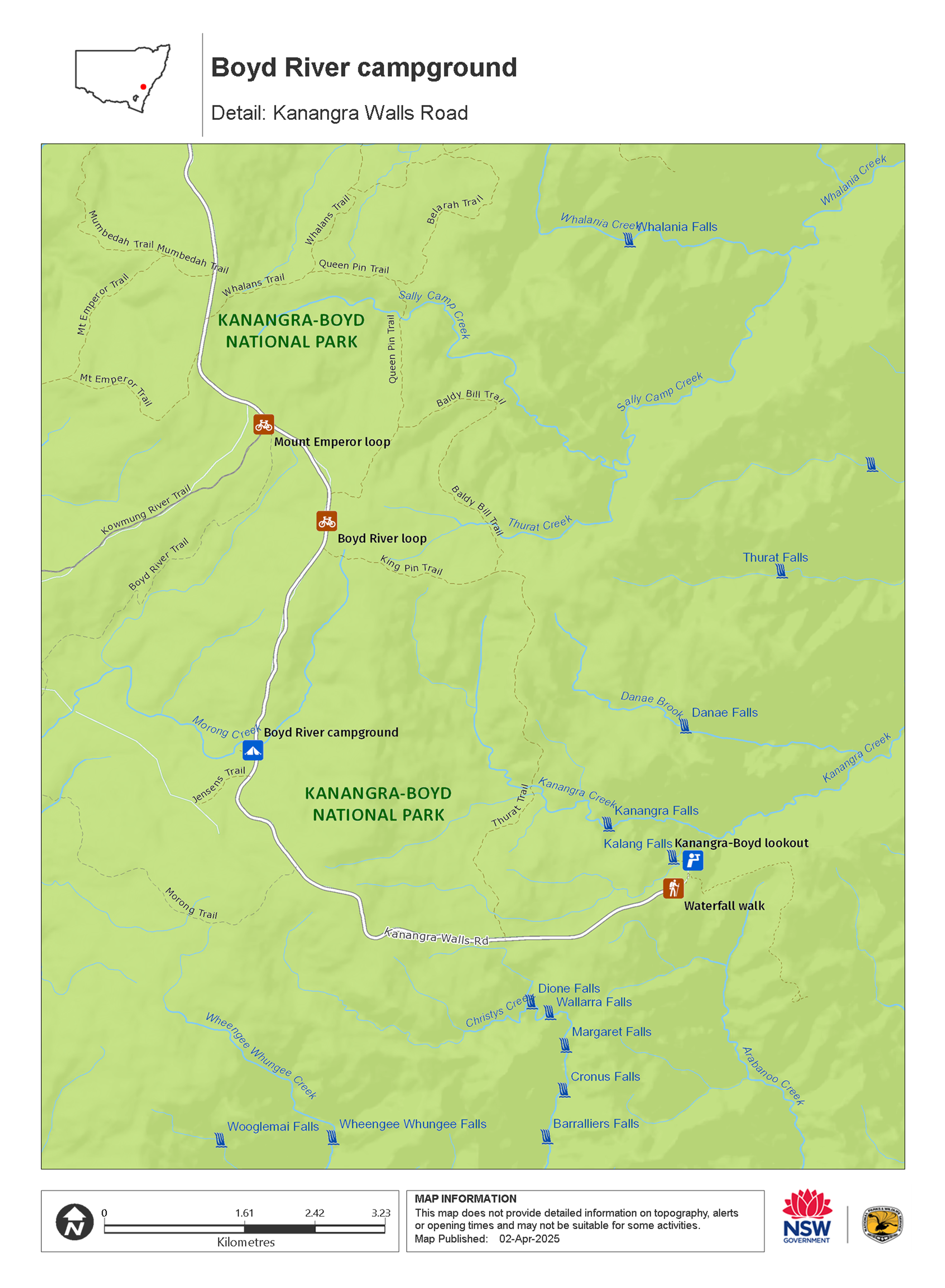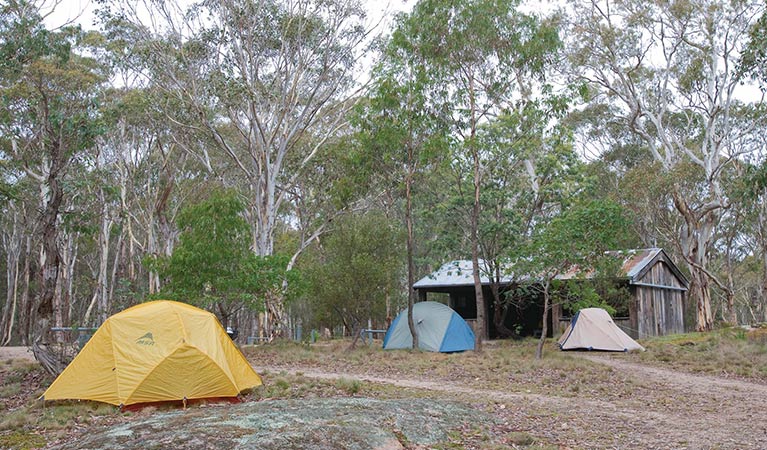Overview
Try camping beneath the snow gums at peaceful Boyd River campground, on the banks of Morong Creek.
| Number of campsites | 10 |
|---|---|
| Camping type | Tent, Camper trailer site, Caravan site, Camping beside my vehicle |
| Where | Kanangra Walls Road, Kanangra, NSW, 2787 - in Kanangra-Boyd National Park |
| Facilities | Toilets, unpowered sites, unmarked sites, barbecue facilities, picnic tables, carpark |
| What to bring | Firewood |
| Price | There are no camping fees at this campground but a $6 booking fee applies. |
| Group bookings | Bookings for up to 5 sites and 20 people can be made online. School groups and commercial tour operators can submit a group booking enquiry form. |
| Please note |
|
Set on the banks of Morong Creek, Boyd River campground offers a peaceful setting in an open forest. Tall snow gums tower above and during early morning and late afternoon some of their inhabitants – sugar gliders, brush-tail possums and tawny frogmouths – can be seen. Wombats, wallabies and kangaroos sometimes join you in the campground. There’s also a recycled timber day hut on site to provide shelter, rain or shine.
Whether you want to go bushwalking, ride mountain bikes, have a keen interest in landscape photography, or are just eager for a getaway, this is the perfect destination. The start of both the lookout and waterfall walks are nearby, and Boyd River loop cycling trail starts in the carpark.
The closest town to the campsite is Oberon, and you can stock up on supplies there. Take a virtual tour of Boyd River campground captured with Google Street View Trekker.
Nearby:
-

Boyd River loop
Take the easy route to peaceful cycling on Boyd River loop, a 21km journey that follows fire trails and roads in Kanangra-Boyd National Park.
-

Mount Emperor loop
A scenic 12.5km ride across the Boyd Plateau, Mount Emperor loop gives mountain bike riders the opportunity to explore some of the lesser-known corners Kanangra-Boyd National Park.
Map

Map legend

Local alerts
For the latest updates on fires, closures and other alerts in this area, see https://www.nationalparks.nsw.gov.au/camping-and-accommodation/campgrounds/boyd-river-campground/local-alerts
Operated by
- Oberon office
- Monday to Friday, 9am to 4.30pm.
- 02 6336 6200
- npws.kanangra@environment.nsw.gov.au
- 38 Ross Street, Oberon NSW 2787
Park info
- in Kanangra-Boyd National Park in the Sydney and surrounds and Country NSW regions
Kanangra-Boyd is always open, but may have to close at times due to poor weather or fire danger.
Visitor info
All the practical information you need to know about Boyd River campground.
Getting there and parking
Boyd River campground is in the Kanangra Walls precinct of Kanangra-Boyd National Park. To get there:
- From Oberon: Turn off the main street onto Ross Street at the National Australia Bank, then follow the signs to Jenolan Caves and Kanangra-Boyd National Park. A 25-minute drive will take you to the park entrance. Follow this road to Kanangra Walls carpark. Allow an hour to get from the entrance to the carpark.
- From Jenolan Caves: Take the exit road to Edith up to the intersection with Kanangra Road. Turn left and continue towards Kanangra Walls for 25km. Watch out for wombats on the road.
Road quality
Check the weather before you set out as the campground can become boggy when it rains.
- Unsealed roads
Vehicle access
- 2WD vehicles
Weather restrictions
- All weather
Parking
Parking is available at Boyd River campground in gravel and roadbase carparks and also at your campsite.
Best times to visit
There are lots of great things waiting for you in Kanangra-Boyd National Park. Here are some of the highlights.
Spring
A beautiful time of year to enjoy hiking and mountain biking; the temperature isn't too hot. The Kanangra Classic, a weekend of outdoor adventure, takes place at Jensens Farm near Boyd River Campground in October. The event includes mountain bike enduros, a social ride and an ultramarathon.
Summer
Take the family camping in the mountains. This is best time of year for canyoning, as well as spotting some of the park's wildlife including kangaroos, echidnas, wombats and lyrebirds.
Winter
With cold temperatures during these months, including the possibility of snow, it's best to walk and mountain bike as part of a day trip. You'll be rewarded with the yellow Kanangra wattle beginning to bloom in late winter.
Weather, temperature and rainfall
Summer temperature
Average
10°C and 23°C
Highest recorded
34.5°C
Winter temperature
Average
-2ºC and 10ºC
Lowest recorded
-10.1ºC
Rainfall
Wettest month
June
Driest month
March
The area’s highest recorded rainfall in one day
200.3mm
Facilities
- Creek water is available at this campground – you’ll need to treat or boil it before drinking.
- Firewood is not provided and may not be collected from this park.
Toilets
There are 2 toilet blocks at the campground:
- The one in the south-east of the campground is accessible, but you'll need to cross over uneven and rocky hard-packed ground and grass to reach it.
- The one in the north-west of the campground is not accessible.
- Non-flush toilets
Types of sites
- Unpowered sites
- Unmarked sites
Barbecue facilities
- Wood barbecues (bring your own firewood)
Picnic tables
Carpark
Step-free access
The campground is flat and step-free, but there are no pathways. You'll need to cross over a mixture of flat grass and hard-packed ground to reach the facilities.
Seats and resting points
Some of the campsites have bench seats.
Maps and downloads
Accessibility
Disability access level - medium
Boyd River campground is mostly flat and step-free, with the following accessible facilities:
- An accessible toilet in the south-east of the campground
- Bench seats at some of the campsites for resting
There are some parts of the campground where people with reduced mobility may need assistance:
- There are no pathways at the campground. You'll need to cross over a mixture of flat grass and hard-packed ground to reach the facilities.
- The ground is uneven and rocky leading to the toilets
Prohibited
Drones
Flying a drone for recreational purposes is prohibited in this area. Drones may affect public enjoyment, safety and privacy, interfere with park operations, or pose a threat to wildlife. See the Drones in Parks policy.
This area may be a declared Drone Exclusion Zone, or may be subject to Civil Aviation Safety Authority (CASA) rules for flying near airports, aerodromes and helicopter landing sites. See CASA's Drone Flyer Rules.
Commercial filming and photography
Commercial filming or photography is prohibited without prior consent. You must apply for permission and contact the local office.
Learn more
Boyd River campground is in Kanangra-Boyd National Park. Here are just some of the reasons why this park is special:
Action adventure

Hardcore hiker? Mad for mountain biking? There's something for whatever level of adventure you desire. Fire trails that wind throughout the park can be explored by 4WD or bicycle. For those who are handy with a map and compass, there's plenty of opportunity for self-reliant bushwalking. There are also marked trails that take in the captivating landscape which are even suitable for the kids. You might even want to throw in a line at Kowmung River to see if you can hook a trout.
- Boyd River loop Take the easy route to peaceful cycling on Boyd River loop, a 21km journey that follows fire trails and roads in Kanangra-Boyd National Park.
- Kanangra-Boyd lookout You can see for miles at Kanangra-Boyd lookout, an easily accessible viewpoint overlooking Kanangra Walls and Mount Cloudmaker.
- Mount Emperor loop A scenic 12.5km ride across the Boyd Plateau, Mount Emperor loop gives mountain bike riders the opportunity to explore some of the lesser-known corners Kanangra-Boyd National Park.
Amazing formations

You can see many unique formations in Kanangra-Boyd National Park, including Thurat Spires, Kanangra Walls, Mount Colong, and waterfall systems - Kalang, Kanangara and Morong. The park also features a series of karst landforms that can be explored by those with caving experience.
- Kalang Falls walk Kalang Falls walk in Kanangra-Boyd National Park offers marvellous views of the cascading water at Kanangra and Kalang Falls.
- Kanangra-Boyd lookout You can see for miles at Kanangra-Boyd lookout, an easily accessible viewpoint overlooking Kanangra Walls and Mount Cloudmaker.
Preserving nature for future generations

There was a time when Kanangra-Boyd was in danger from logging and the extraction of lime. That all changed after a five-year conservation effort resulted in it being declared part of Greater Blue Mountains Area World Heritage Property in 1972.
Wonderful wilderness

High plateaus and sheltered slopes mean Kanangra-Boyd has a diverse range of plantlife, some of it unique to the national park. Heath and mallee dominate the areas exposed to wind and weather, while tall snow gum forests can also be found in the park. Look for the yellow Kanangra wattle that grows only on the rivers - it flowers from early spring to late winter. The wildlife population is extensive too. Keep your eyes peeled for red-necked wallabies, which thrive in this area. Honeyeaters, wrens and fruit-eating pigeons are just some of the 195 species of birds that can be spotted in the park on a daily basis.
- Kalang Falls walk Kalang Falls walk in Kanangra-Boyd National Park offers marvellous views of the cascading water at Kanangra and Kalang Falls.
- Kanangra-Boyd lookout You can see for miles at Kanangra-Boyd lookout, an easily accessible viewpoint overlooking Kanangra Walls and Mount Cloudmaker.
Plants and animals protected in this park
Animals
-

Spotted-tailed quoll (Dasyurus maculatus)
The spotted-tailed quoll is the largest remaining carnivorous marsupial on the Australian mainland. It’s protected as a vulnerable species in NSW.
-

Short-beaked echidna (Tachyglossus aculeatus)
One of only 2 egg-laying mammals in the world, the short-beaked echidna is one of the most widespread of Australian native animals. Covered in spines, or quills, they’re equipped with a keen sense of smell and a tube-like snout which they use to break apart termite mounds in search of ants.
-

Superb lyrebird (Menura novaehollandiae)
With a complex mimicking call and an elaborate courtship dance to match, the superb lyrebird is one of the most spectacular Australian animals. A bird watching must-see, the superb lyrebird can be found in rainforests and wet woodlands across eastern NSW and Victoria.

